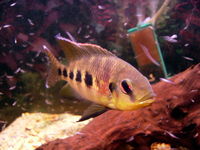Tiger Tilapia (Tilapia mariae)
From The Aquarium Wiki
Tilapia mariae
246 Litres (65 US G.)
35-40 cm (13.8-15.7")
6.0 - 8.0
20 -25 °C (68-77°F)
5-19 °d
1:1 M:F
5-8 years
Family
Cichlidae
Contents
Additional names
- Spotted Tilapia, Spotted Cichlid, Spotted Mangrove Cichlid, Black Mangrove Cichlid
Additional scientific names
- Pelmatolapia mariae
Origin[edit]
- Coastal lagoons and lower river courses from the Tabou River Cote d'Ivoire to the Kribi River, Cameroon, but absent from the area between the Pra River, Ghana and Benin. Also recorded from the lower Ntem, Cameroon.
Sexing[edit]
- Males tend to have longer dorsal and caudal fins than females, which are covered with small, shimmering white spots. Males often have a steeper rise to their forehead, and are typically larger than females of the same age.
Tank compatibility[edit]
- Spotted Tilapia can be aggressive, and should only be added to tropical tanks at the exact same time as other fish, to avoid fights over territory. They will eat fish smaller than themselves and should only be housed with similar-sized robust fish.
Diet[edit]
- They will feed on small invertebrates such as shrimp, and will eat any fish food. They also have the ability to filter feed on zooplankton. They are also particularly fond of water plants, but prefer prepared fish food.
Feeding regime[edit]
- Feed once, twice, or thrice a day, depending on wanted growth rate and age; younger fish should be fed more than older fish, but feeding should be slowed when fish has reached wanted size.
Environment specifics[edit]
- Spotted Tilapia are freshwater fish that do well in brackish water, but cannot spawn in seawater. They require warm water, and cannot survive long in water 15.6°C (60°F) or lower. Death occurs at 10°C (50°F) . Water must be at least 21.1°C (70°F) for digestion of food.
Behaviour[edit]
- Spotted Tilapia are monogamous fish that stay in pairs for life. One will be on guard while its partner eats. Very aggressive when spawning. Both parents guard the young, and will chase away any predators. Like other Tilapia, they are easily spooked by humans and like to hide. They will feed throughout the water column.
Identification[edit]
- Dark vertical bands on a lighter olive green background which fade with age. When bands fade, dark blotches on the lateral line become more evident. Eyes are red with a black stripe running through. 16 spines on dorsal fin (occasionally 15), with 12-13 soft rays. Anal fin has 3 spines, and 10-11 rays. 13-15 short gill rakers on the lower anterior gill arch. It is one of the smaller Tilapia, with a maximum size of 38.1cm (15"), and a typical size of 15.2-20.3cm (6-8").
Notes[edit]
- Highly invasive in warm areas. Well established in Southern Florida, where their possession is illegal.
Pictures[edit]
External links[edit]
- Fishbase (Mirrors:
 )
)
